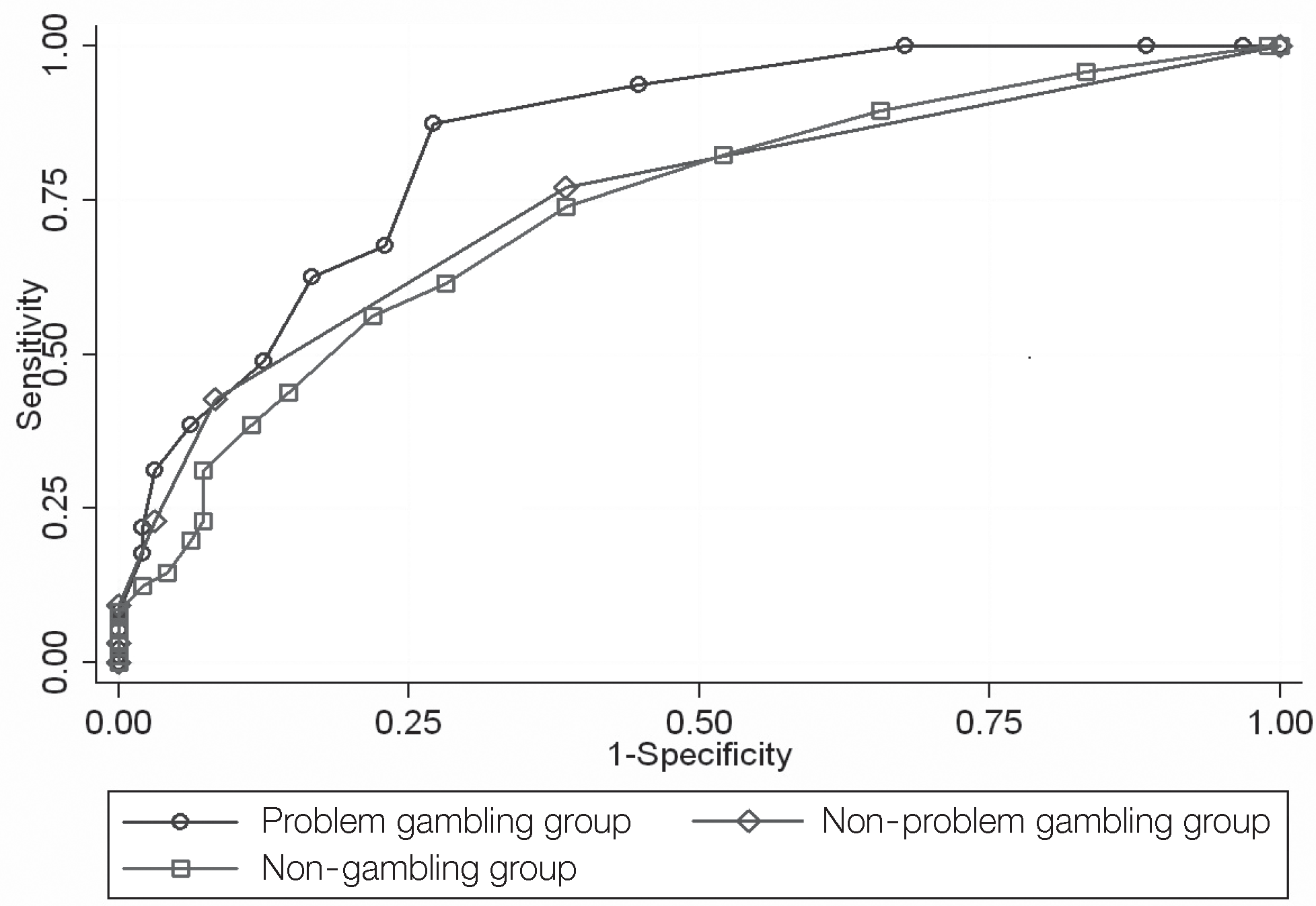Abstract
Methods
The process involved construction of a conceptual framework, initial item search, verification of content validity, selection of secondary items, and extraction of final items. The participants were 299 adolescents from two middle schools and four high schools. Item analysis, factor analysis, criterion validity, internal consistency, and ROC curve were used to analyze the data.
Results
For the final scale, 25 items were selected, and categorized into 4 factors which accounted for 54.9% of the total variance. The factors were labeled as loss of control, life dysfunction from gambling addiction, gambling experience, and social dysfunction from problem gambling. The scores for the scale were significantly correlated with addictive personality, irrational gambling belief, and adolescent's gambling addictive behavior. Cronbach’s alpha coefficient for the 25 items was .94. Scale scores identified adolescents as being in a problem gambling group, a non-problem gambling group, and a non-gambling group by the ROC curve.
References
Barnes G. M.., Welte J. W.., Hoffman J. H.., Tidwell M.C. 2010. Comparisons of gambling and alcohol use among college students and non-college young people in the United States. Journal of American College Heath. 58:443–452. http://dx.doi.org/10.1080/07448480903540499.

Blinn-Pike L.., Worthy S. L.., Jonkman J.N. 2010. Adolescent gambling: A review of an emerging field of research. Journal of Adolescent Heath. 47:223–236. http://dx.doi.org/10.1016/j.jadohealth.2010.05.003.

Chon K. K.., Choi S. C.., Yang B.C. 2001. Integrated adaptation of CES-D in Korea. The Korean Journal of Health Psychology. 6:59–76.
Desai R. A.., Maciejewski P. K.., Pantalon M. V.., Potenza M.N. 2005. Gender differences in adolescent gambling. Annual of Clinical Psychiatry. 17:249–258. http://dx.doi.org/10.1080/10401230500295636.

Eaton D. K.., Kann L.., Kinchen S.., Shanklin S.., Ross J.., Hawkins J., et al2008. Youth risk behavior surveillance: United States, 2007. Morbidity & Mortality Weekly Report. 6:1–131.
Field, A. 2000. Discovering statistics using SPSS for Windows. London: Sage.
Gottfredson M.., Hirschi, T. 1993. Commentary: Testing the general theory of crime. Journal of Research in Crime and Delinquency. 30:47–54. http://dx.doi.org/10.1177/0022427893030001004.

Griffiths, M. 2002. Adolescent gambling: What should teachers and parents know? Education and Health. 20(2):31–35.
Gupta R.., Derevensky J.L. 2000. Adolescents with gambling problem: From research to treatment. Journal of Gambling Studies. 16:315–342. http://dx.doi.org/10.1023/A:1009493200768.
Haber J.., Lobiondo-Wood, G. 2006. Reliability and validity. Lobi-ondo-Wood G., Haber J., editorsNursing research. 6th ed.p. 335–399. St. Louis, MO: Mosby Elsevier.
Hyder A. A.., Juul N.H. 2008. Games, gambling, and children: Applying the precautionary principle for child health. Journal of Child and Adolescent Psychiatric Nursing. 21:202–204. http://dx.doi.org/10.1111/j.1744-6171.2008.00155.x.

Kadioglu H.., Sisman F. N.., Ergun, A. 2012. Reliability and validity of the Turkish version of children's somatization inventory. Asian Nursing Research. 6:9–12. http://dx.doi.org/10.1016/j.anr.2012.02.004.

Kim H.J. 2009. A study of the factors influencing adolescent gambling behavior. Unpublished master's thesis. Chungnam National University;Daejeon:
Kim K.H. 2007. A way to overcome addiction, the modern dungeon. The Korean Journal of Health Psychology. 12:677–693.
Kwon S. J.., Kim K. H.., Choi J.O. 2006. Awareness of adult gambling and predictors of gambling behavior in children. The Korean Journal of Health Psychology. 11:147–162.
Lee H.P. 2003. The effect of irrational gambling belief to the pathological gambling. The Korean Journal of Clinical Psychology. 22:415–434.
Lee H.S. 1997. Korean version Eysenck Personality Questionnaire. Seoul: Hakjisa.
Lee H. S.., Kim, Y. 2002. Korean SPSS 10.0 guide for the beginner. Seoul: Bubmoonsa.
Lee S. M.., Kim J.N. 2009. Evaluation/diagnosis and related rates reflection the nature of gambling problems. The Korean Journal of Health Psychology. 14:1–26.
Nam H. M.., Ok S.H. 2001. The effects of psychological family environment, self-control, and friends characteristics of middle school students on their problem behaviors. Journal of the Korean Home Economics Association. 39:37–58.
Park Y.K. 2002. A study on actual analysis of juvenile delinquency in Korea. Unpublished master's thesis. Kyonggi University;Suwon:
Ryu C.S. 2006. SPSS 14.0 for windows. 5th ed.Seoul: Elite.
Selekman, J. 2008. Gambling: Normal adolescent activity or pathologic ad-diction? Pediatric Nursing. 34:325–328.
Table 1.
Factor Analysis for Final Items (N=299)
Table 2.
Correlation of Gambling Addictive Behavior for Adolescents with related Variables (N=299)
| Variables |
Addictive personality |
Self-control |
Irrational gambling belief |
Gambling behavior* |
|---|---|---|---|---|
| r (p) | r (p) | r (p) | r (p) | |
| Self-control | −.54 (<.001) | |||
| Irrational gambling belief | .45 (<.001) | −.39 (<.001) | ||
| Gambling behavior* | .52 (<.001) | −.49 (<.001) | .35 (<.001) | |
| Gambling addictive behavior for adolescents | .55 (<.001) | −.49 (<.001) | .29 (<.001) | .59 (<.001) |
| Loss of control | .57 (<.001) | −.59 (<.001) | .36 (<.001) | .33 (<.001) |
| Life dysfunction from problem gambling | .49 (<.001) | −.39 (<.001) | .24 (<.001) | .62 (<.001) |
| Gambling experience | .51 (<.001) | −.50 (<.001) | .29 (<.001) | .71 (<.001) |
| Social dysfunction from problem gambling | .41 (<.001) | −.36 (<.001) | .23 (<.001) | .34 (<.001) |




 PDF
PDF ePub
ePub Citation
Citation Print
Print



 XML Download
XML Download